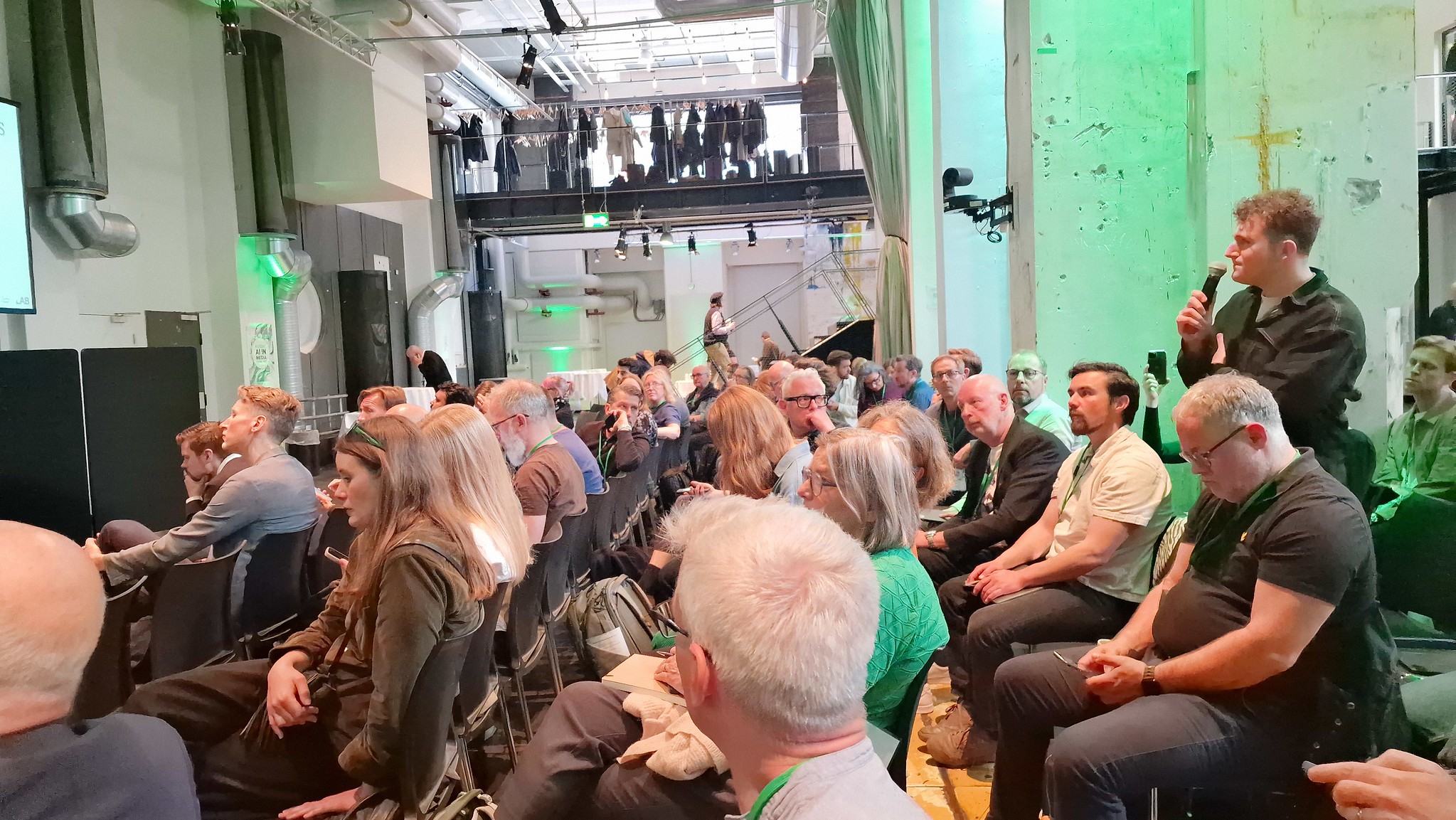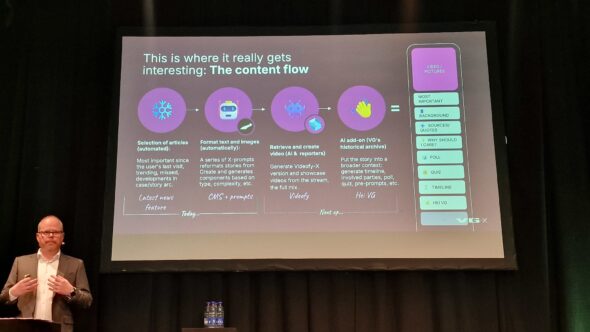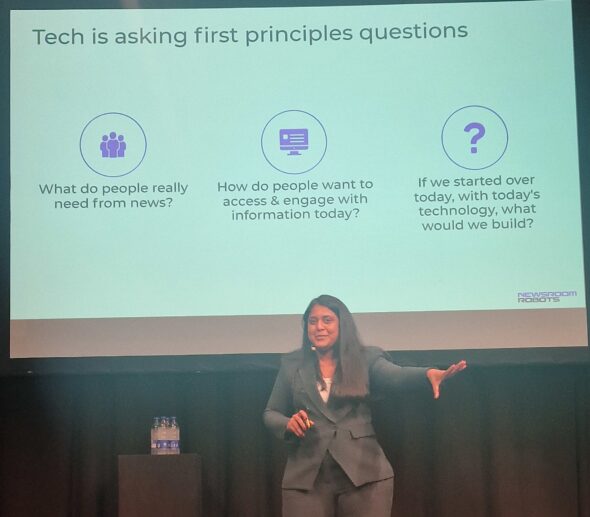Keeping the Audience in the Loop – my NAMS takeaways

NAMS25 took place at Pressen in Copenhagen.
The Nordic AI in Journalism Summit (NAMS) 2025 opened with a dramatic declaration – the article is dead. What followed was a thought-provoking day for journalists, media executives, developers and entrepreneurs gathered at Pressen – the former printing hall of JP/Politiken and a fitting venue for journalism in transformation.

Erja Yläjärvi, Senior Editor-in-chief at Helsingin Sanomat, presenting at NAMS.
As I was unable to attend last year, I was really excited to finally get to participate. And I leave the conference with a lot of thoughts about how AI can be both a threat to journalism and democracy and its saviour. One thing is certain, journalism as we know it will change. Co-organizer Agnes Stenbom of IN/LAB called for a reconsideration of what journalism is and should be in society. Several speakers talked about redefining our role in society. And at the same time, core journalistic values have never been more important.
“Focus on the quality of journalism and the quality of audience connections”, said Alexandra Borchardt, lead author of the EBU News Report that was actually released on that very day. She argued that AI is merely a means to an end and that every news organisation needs to define what quality journalism and audience connection mean for them.
Journalist and writer Ida Ebbensgaard underscored that “the core concept of journalism is that we are accountable. Is it a good story and can you trust it? A bot cannot have that responsibility”, she said.
As media companies try to redefine their workflows, business models and output, we were repeatedly reminded: don’t forget the audience! “If the audience is not considered in how these algorithms are developed and deployed, there’s a risk of eroding trust in the entire news ecosystem”, said Ida Ebbensgaard.
Don’t innovate based on what YOU want or think, ask the audience – keep them in the loop. And not just the audience you have, the one that you are missing. Here Gard Steiro, editor-in-chief of VG, made a good point: if you’re building something new to increase your reach, you cannot test it on your loyal audience, who likes you fine the way you are – you have to find new users to help you test it. This is what they did with their experiment VG X. Steiro emphasized the need for experimentation. “Will it work? Probably not. Will we learn something? For sure. Will some of the features be integrated in the core product? Definitely.”

Gard Steiro, Editor-in-Chief at VG, shows the content flow for VG X.
There is a crisis in media that isn’t caused by the new wave of powerful AI models. It’s much more fundamental. Traditional media (yes, including digital media here) just isn’t relevant enough for the younger generations used to the speed and quick attention shifts of tiktok, instagram and youtube. It’s not that they aren’t interested in the world around them, it’s that traditional forms of news don’t work for them.
One proposal to mitigate this is what is sometimes called liquid content, fluid journalism, particle journalism, fractal stories, modular journalism. The latter was proposed by the London School of Economics’ JournalismAI in 2021. It’s the idea that journalism can be produced in smaller, independent chunks, news artefacts to be put together in different ways, with different tones and lengths, depending on the medium and the target audience. With the help of AI, text can become audio, images can become video. “Anything can become anything”, as keynote speaker Ezra Eeman of NPO put it. There has been some experimentation in this over the past years. But little from Nordic media outlets apart from the “answer engines” types of chatbots that lets users chat with a site’s content on a topic or as a whole.
The idea that AI could put these different versions of the same story together means we, as journalists, as publishers, will have to let go of the control over the output. Futurist Sofie Hvitved said: “It’s about losing control. You will not have control over the final product.”
Even more so when AI agents enter the playing field. Will we see the death of the web as we know it as well? If we can’t be bothered to search, but set agents to work for us, and they are served by other agents, what will the web look like? These are questions worth considering when building news apps and sites.
Keynote speaker Nikita Roy, Founder of Newsroom Robots Labs & ICFJ Knight Fellow, repeated the idea that we need to start preparing for the death of the article as we know it. “It’s actually a container for a bunch of data points: quotes, facts, analysis … […] This is already happening. What Google is doing with its podcast is taking these data points from different sources and restructuring them”, she said.

Nikita Roy at NAMS.
Compared to last year, it seems AI adoption in the newsroom is much more widespread. But a lot of it focuses on streamlining old processes, not rethinking what they can be. As co-organizer Kasper Lindskow, Head of AI at JP/Politiken, noted in his summary on LinkedIn, “both our users and tech companies are moving at greater speeds”. Keynote speaker Ezra Eeman, Direcor of strategy and transformation at NPO, said there’s a “clear gap between individual use and organizational adoption”. And might it be that this transformation is lead bottom-up? As one very experienced media leader told me, “it’s often the editors-in-chief that hinder progress and transformation”.
Erja Yläjärvi, Senior Editor-in-chief at Helsingin Sanomat, compared the AI transformation in media with the smaller shift that came with data journalism. Then the editor-in-chief didn’t need to understand the process. But now, “if your editor-in-chief doesn’t know what automating the news is about, you’re in trouble”, she said.
Having been to a lot of seminars the past year where Europe has always been seen as lagging behind, with the US as the frontrunner and great innovator, it was interesting to hear that at least the Nordic countries are actually way ahead when it comes to AI adoption in journalism. This being said by American journalists. But that is a small comfort when you look at how far behind the media industry is when compared to the tech giants, who, in the words of keynote speaker Nikita Roy, “are having interactions [with users], understanding at an individual level, what our mindset is, what we want at that moment in time”. That is hard to beat.







Recent Comments